September doesn’t just mark the beginning of fall, it’s also National Preparedness Month, and it’s a good reminder that emergencies and disasters can happen at any time. With homeownership comes the responsibility of having to plan ahead for life’s unknowns. Emergencies come in many forms, depending on your local climate. So whether its more likely that you and your household need to prepare for the potential of a wildfire, earthquake, or a winter storm, it’s crucial to have resources on hand to limit the damage to your home and to protect your household.
You should always be prepared by reviewing safety protocols, emergency supplies and more with your family. This is a topic that we love to share and talk about, so if you have any questions – – contact us and just ask!
STEPS TO TAKE:
What steps can you take for National Preparedness Month? While most disasters don’t provide advanced warning, there are some steps you can take to prepare for any natural disaster or emergency:

1. CREATE A HOME INVENTORY LIST
In the wake of any natural disaster or emergency event, it can be difficult to remember the exact details of all your belongings. Creating a home inventory helps you know what possessions you have and exactly where they’re located. This will be beneficial should you need to file an insurance claim post-disaster. Remember to:
- Take photographs of relevant rooms and items in them.
- Jot down descriptions of each item, including the make, model and serial number of each item.
- Record a video of all your items. Walk through your living space, recording video of your items and describe aloud what each item is and looks like.
For further tips on creating a home inventory check out this checklist.
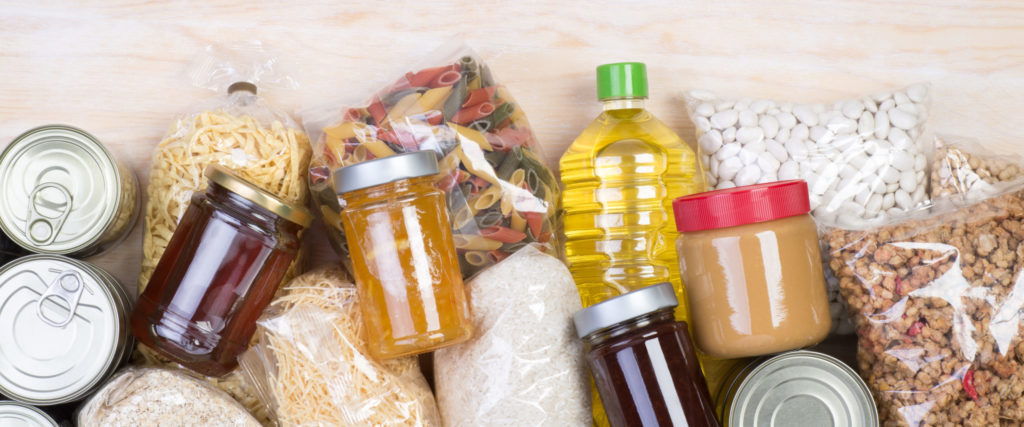
2. HAVE A WELL STOCKED FOOD & WATER SUPPLY
FEMA recommends that you need to have a three-day supply of non-perishable food and water for each family member, including your pets, for emergency preparedness. If you are going to err on the side of caution, you can have even more on hand. Having this emergency food on hand doesn’t take a big investment, especially if you purchase food items that last a long time.
As you buy food, consider preparation. If you have no gas or electric service, would you be able to cook oatmeal? Canned nuts and peanut butter and jelly on crackers may be a better choice. Of course, you could create an outdoor fire, if the disaster did not cause too much of a mess, but make sure you have some types of food that are easy to make or ready to eat as they are.
Here are some items you should buy for your emergency food supply, and the length of time they should last if stored properly:
- Water: Store one gallon per person per day, for at least three days, for drinking and sanitation, and have ways to treat dirty water via either a portable water filter or countertop water filter. We love these AquaBricks for water storage, and WaterBOB for a quick emergency to fill your tub with water.
- Freeze-dried emergency food: ReadyWise is a great company if you’re looking for somewhere to start.
- Ready-to-eat canned foods: Meats, fruits and vegetables
- Snacks: Peanut butter, nuts, protein bars, crackers, dried fruit
- Bulk items: Rice, flour, salt, instant potatoes, vegetable & bone broth, pasta & sauce, etc.
- Cooking: Oils, instant yeast, powdered milk, etc.
- Comfort foods: Chocolate, cookies or other high-calorie sweets, instant coffee
- Baby food & formula, along with bottles, diapers, wipes and anything else your baby might need
- Pet food and water
- Disposable plates, cups, utensils and a can opener
For more recommended food choices, check out this list on ready.gov.
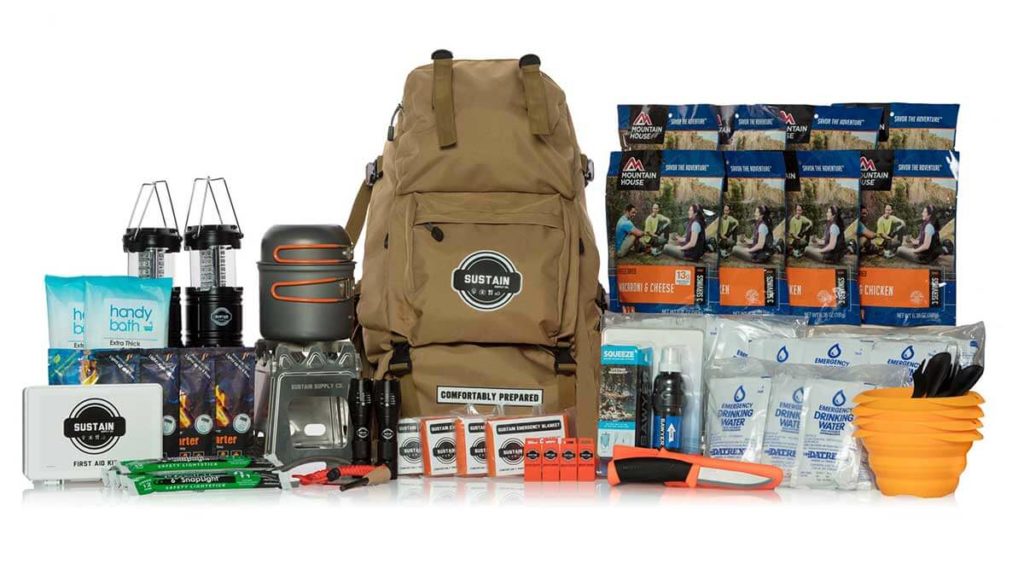
3. HAVE SUPPLIES ON HAND
Spend some time finding out which supplies, and items are worth packing when building your own emergency survival kit. Recommended supplies include:
- First aid kit: We love MyMedic for home and travel kits, and don’t forget your Pet First-Aid Kits as well!
- Power: A generator with propane is crucial to have if the power goes out, spare batteries and rechargers, as well as solar chargers for your phone or other small electronics
- Fire: lighters, matches, and backup fire starters or laundry lint to start a fire
- Light: headlamps, flashlights, candles, lanterns
- Heating and cooling: indoor-safe heaters, extra blankets, sleeping bags, USB-powered fan
- Shelter: a tarp comes in handy for improvised shelter, plugging holes in the house, and clearing debris
- Medical: list of 145 prioritized home medical supplies
- Hygiene: wet wipes, hand sanitizer, personal hygiene items, camp soap, garbage bags
- Communication: either a one-way NOAA radio or a two-way ham radio (if you know how to use it)
- Tools: knives (big & small), axe, shovel, work gloves, rope, wrench for your gas lines, zip ties, duct tape, fire extinguisher, self defense, etc.
- Mental health: board games, favorite books, headphones, movies, etc.
- Documents: copy of deeds/titles, insurance policies, birth certificates, maps, pictures of family members, etc. in both physical and USB thumb drive forms. Don’t forget any records for your pets as well!
- Utilities: Learn about when and how to turn off utilities such as water, electricity, and gas. If you need tools to turn off gas and water, keep these at the shut-off valves. Turn off utilities if you suspect damage.

4. BE FINANCIALLY PREPARED
It’s best to have a source of financial savings if a natural disaster strikes. Have some money saved in an emergency savings account that can be used in a crisis. Additionally, consider keeping a small amount of cash on hand in case you don’t have access to an ATM. In extreme situations, credit and debit cards may not work. Make sure to have a mix of small and large bills, as you may not find people who can break a $100 in emergency situations.
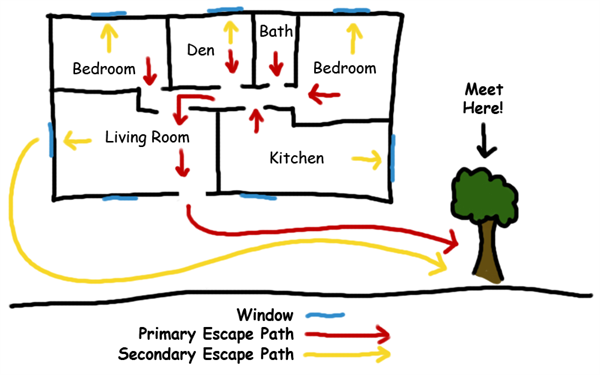
5. CREATE A DISASTER EMERGENCY PREPAREDNESS PLAN
A disaster preparedness plan is a plan of action for you and your family in case of an emergency or disaster. Planning tips include:
- Review escape routes in your home so everyone knows how to escape in the event of an emergency. Make sure these exits are always kept clear.
- Identify other places you can go in an emergency; this could include a friend or family member’s home, a motel or safe house. Having locations in different areas gives you options during an emergency.
- Give important phone numbers to every family member so everyone can contact each other after a disaster. Teach children how to make emergency phone calls.
- Make a plan to evacuate with pets, if necessary. If shelters don’t allow pets, animals may need to be boarded elsewhere.
- Sign up for local emergency alerts.
- Write down important contact numbers, know the location of the nearest hospitals, etc.
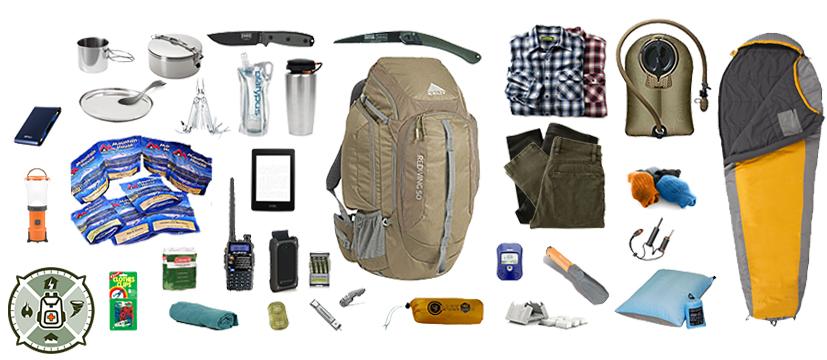
6. HAVE A ‘GO BAG’ IN CASE YOU HAVE TO LEAVE YOUR HOME
Building a go bag, (sometimes called a bug out bag, INCH bag, 72 hour kit, emergency kit, etc.) is one of the most important steps you should take to get prepared. These packed and ready bags serve as your “I need to leave home right now!” to escape the risks of an emergency scenario caused by natural disasters like earthquakes or situations like civil unrest. Therefore, a typical go bag contains essentials that can sustain you for at least three days away from the comfort of your home. Even if you never use it, the peace of mind that comes with knowing you can handle almost anything is well worth the cost. You can buy pre-packed ‘go bags’, but we recommend getting a backpack that fits your frame, and packing it with essentials that are specific to you and your family. Here’s more information on what to include in your go bag: Bug Out Bag Essentials, along with a visual checklist that you can save and reference.
Maintain the Plan and Kit for Emergency Preparedness
Review your disaster plan every six months to ensure that it remains up to date. Quiz family members periodically to ensure that everyone knows what to do in an emergency. Conduct regular escape and evacuation drills with family members, having everyone meet at a designated spot outside. Restock food and medical supplies in the disaster kit to keep items fresh. Discard expired items. Test smoke and carbon monoxide detectors twice each year, replacing batteries as necessary. Test fire extinguishers, following manufacturer recommendations for recharging them. Getting prepared takes some time and money, but gives you a peace of mind for you and your family.
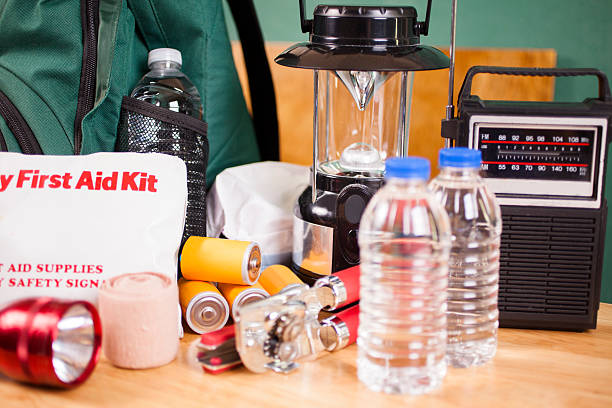
View Comments
+ leave a comment